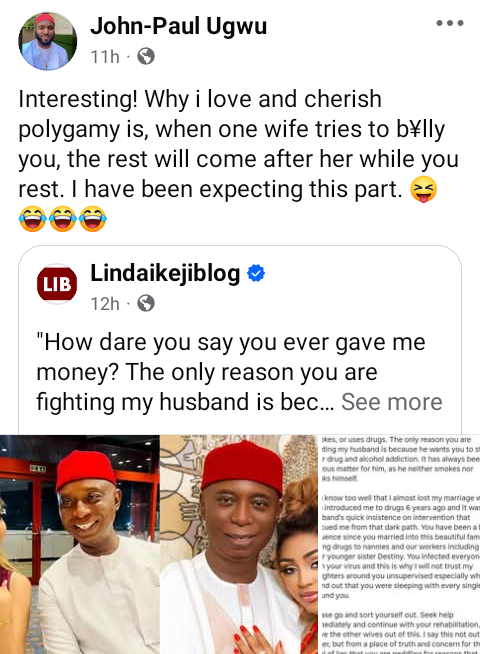The Price of Envy: A Nollywood Drama That Bites Back
Logline: When a wealthy man brings a naive village girl into his opulent world, the simmering jealousy of his former lover explodes into a slow-burn, psychotic plot for revenge.
BDANIELS TV’s 2025 release, THICK AND THIN, starring Nollywood titans Frederick Leonard, Frances Ben, and Vivian Gabriel, arrives with the promise of a dark, character-driven thriller. And for the most part, it delivers on its tension.
However, let’s establish the core thesis upfront: The film offers a compelling, if structurally uneven, critique of corrosive envy, elevated by two powerhouse lead performances but ultimately restrained by its reliance on overt melodrama and a sensationalized approach to mental illness. It is a fascinating but flawed entry into the contemporary Nollywood canon, proving that while ambition is high, the execution occasionally buckles under the weight of its own dramatic impulses.
This review will dissect the film’s mechanics, analyzing how its narrative engine sputters just as its thematic depth begins to engage the viewer, and why the strength of its acting ultimately makes it a necessary, if cautionary, viewing experience.
1. Plot Mechanics: Pacing and the Problem with Contrivance
THICK AND THIN begins conventionally, establishing the easy-going romance between the successful Davidson (Leonard) and the innocent, out-of-town Suso (Ben). This opening act is crucial; it grounds the stakes in genuine affection and contrast—Suso’s rustic simplicity against Davidson’s polished privilege.
The Abrupt Narrative Shift
The initial pacing is smooth, almost pastoral, quickly giving way to the arrival of Leila (Gabriel), Davidson’s spurned former partner. This is where the narrative shifts. Leila is not just heartbroken; she is possessed by a toxic cocktail of wounded pride and class entitlement. Her jealousy is palpable, but the film makes a crucial misstep by accelerating her descent too quickly. The transition from scorned ex-lover to methodical schemer, utilizing a slow-acting poison, feels less like a natural escalation of psychosis and more like a convenient mechanism to kickstart the thriller elements.
The film sacrifices organic character development for dramatic convenience. We are shown Leila’s malice, but we are rarely allowed to fully understand the internal mechanism that drives a sophisticated woman to such a medieval act of cruelty.
Suspense and the Climax
The middle act—Sus’s deterioration, Davidson’s helpless confusion, and Leila’s chilling charade of concern—is where the film truly shines as a suspense vehicle. The use of dramatic irony is effective: as the audience, we know Suso is being poisoned, creating a palpable dread as her sanity is questioned by everyone around her.
However, the climax, centered on the CCTV revelation, ultimately lands as predictable rather than satisfying. In a film that builds so much tension around psychological torment and doubt, resolving the conflict through a simple technological convenience feels anti-climactic. A truly profound thriller would have forced Davidson to confront his own obliviousness or forced Suso to actively expose Leila despite her weakened mental state. Instead, technology provides a deus ex machina, softening the thematic punch.
2. The Human Element: Character Development & Performance Showcase
The film’s greatest asset, and the element that allows it to survive its structural flaws, is the sheer force of its central trio’s performances.
Suso’s Descent: Victim or Protagonist?
Frances Ben, as Suso, shoulders the immense burden of portraying a woman systematically dismantled. Her performance is initially captivating, successfully rendering the wide-eyed wonder of a village girl navigating Lagos high society.
The critique lies in the character’s agency. As the poisoning progresses, Suso transitions almost entirely into a plot device—a pawn whose mental breakdown serves to heighten Leila’s evil. Ben masterfully executes the symptoms (paranoia, confusion, physical weakness), capturing the terror of a mind betraying its own body. Yet, the writing gives her little room for active resistance. We desperately want Suso to fight back, to channel her fear into defiance, but she remains largely passive, defining her role as the tragic victim rather than the battling protagonist. This is a missed opportunity for true dramatic depth.
Leila: The Two Faces of Envy
Vivian Gabriel delivers a truly chilling, career-defining performance as the antagonist, Leila. Gabriel understands that true villainy is often cloaked in charm. Initially, Leila is poised, calculating, and dangerously subtle. Her interactions with Suso and Davidson are laced with passive aggression and veiled threats that resonate far more than any overt screaming match.
However, the performance occasionally tips into what might be termed histrionics—a staple of Nollywood melodrama. In moments of private triumph, Leila’s exaggerated gloating threatens to pull the character back into the realm of the one-dimensional villain. This isn’t a fault of Gabriel’s commitment, which is total, but a stylistic choice by the director that lessens the complexity of a woman clearly driven by deep-seated issues of entitlement and self-worth. When she is restrained, she is terrifying; when she is expressive, she is merely theatrical.
Davidson: The Oblivious Anchor
Frederick Leonard, as Davidson, plays the necessary anchor in this chaotic storm. Davidson is the epitome of the successful, well-meaning man who is utterly blind to the machinations happening in his own home. Leonard excels at portraying a convincing blend of charm, confusion, and genuine panic.
His performance is crucial because he acts as the audience’s proxy for doubt. Leonard’s subtle shift from doting partner to confused caregiver who begins to question Suso’s sanity is entirely believable. He grounds the narrative in reality, preventing the entire ordeal from floating into pure farce. If his disbelief hadn’t been authentic, the story would have instantly collapsed.
3. Technical Merits: Cinematography, Score, and Mise-en-scène
THICK AND THIN showcases the continued improvement in Nollywood’s technical capacities, though it retains some of the industry’s aesthetic habits.
A Study in Contrast: Set Design
The film’s set design is arguably its strongest technical feature, acting as a visual thematic critique of class. Davidson’s home is a monument to modern affluence—sterile, spacious, and often sparsely populated. This mise-en-scène brilliantly highlights Suso’s isolation, making her feel like a trespasser in an environment that is too polished for comfort. The juxtaposition with the brief, vibrant shots of her village is stark and effective, emphasizing the gulf in class that Leila exploits.
Cinematography and Lighting
The cinematography is largely competent, utilizing close-ups effectively to capture the paranoia in Suso’s eyes and the cold calculation in Leila’s demeanor. However, in the film’s many interior scenes, the lighting can feel flat and overly bright, which detracts from the suspense. True psychological thrillers rely on shadow and depth to foster unease; here, everything is exposed, forcing the actors to do the heavy lifting of creating atmosphere through performance alone.
The Overbearing Score
The film is let down by its musical score. This is a recurrent critique in contemporary Nigerian cinema. Instead of allowing the actors’ expressions or the dialogue’s implication to carry the emotional weight, the score often screams its intentions. During Suso’s most fragile, paranoid moments, the swelling, mournful violins are deployed with relentless intensity. This over-dramatization robs the scenes of their nuance, telling the audience how to feel rather than allowing the psychological horror to sink in naturally.
4. Thematic Deep Dive: Envy, Class, and the Medicalization of Evil
THICK AND THIN attempts to weave several complex themes into its tightly wound plot, succeeding with its commentary on societal ills but faltering in its handling of a critical subject: mental health.
The Corrosive Nature of Envy
At its core, the film is a portrait of envy. Leila’s motive isn’t just about winning Davidson back; it’s about eliminating a perceived social inferior who has successfully breached the wall of her elite class. The subtle venom she spits at Suso—disguised as mentorship—is far more dangerous than any fistfight. It’s a critique of how social hierarchies breed a toxic sense of entitlement that justifies cruelty toward outsiders. The film is remarkably effective in demonstrating the slow, mind-numbing destruction that unchecked jealousy can inflict, both on the victim and the perpetrator.
The Trouble with Psychosis
The film takes a significant thematic risk by linking the slow-acting poison directly to a temporary state of psychosis that mimics severe mental illness. While the dramatic intent is clear—to show the vulnerability of the human mind—the execution is potentially problematic.
By using symptoms of a serious psychiatric condition (paranoia, hallucinations, dissociation) as a plot device fueled entirely by an external drug, the film risks sensationalizing and simplifying mental illness. It suggests that such extreme paranoia must have a clear, external, and ultimately curable cause, sidestepping the complex, often heartbreaking reality of clinical mental health challenges. A more nuanced approach would have allowed Suso’s underlying anxieties to be exacerbated by the poisoning, rather than having the poisoning create the psychosis entirely. This feels like a missed opportunity to offer a more responsible, contemporary commentary on genuine psychological struggles.
Social Critique
Despite these flaws, the film successfully uses Suso as a metaphor for the marginalized. Her initial naivety is a reflection of her trust in a world she doesn’t fully comprehend. Her eventual fate is a stark reminder that in the face of elite, focused malice (Leila), the innocent are often deemed hysterical or crazy when they speak the truth. The movie forces the audience to confront how easily we doubt the vulnerable and side with the composed, well-dressed liar.
5. Verdict & Final Thoughts
THICK AND THIN is a bold, if bumpy, ride into the dark side of ambition and envy. Its power resides firmly in the shoulders of its lead actors. Vivian Gabriel provides a memorable, spine-tingling villainess, while Frances Ben channels authentic, visceral horror as her victim. Frederick Leonard anchors the chaos with believable human concern.
The film earns significant credit for tackling themes of class tension and the destructive nature of obsession. However, its resort to melodrama in pivotal moments and its convenient technological solution to a deeply psychological conflict prevent it from achieving true cinematic excellence.
It is a film that will generate discussion, particularly around the ethical portrayal of its central conflict, but it is undeniably compelling television.
Verdict: Watch on Streaming. The performances are too strong to ignore, and the suspenseful setup works wonders, even if the landing is slightly soft.
Star Rating: …………… 3.5/5 Stars.
Call-to-Watch
THICK AND THIN is now available to stream on BDANIELS TV platforms. Go watch the film, and pay close attention to the subtle cues in Vivian Gabriel’s performance—it’s a masterclass in slow-burn villainy that Nollywood fans will be dissecting for months! Come back and let us know: Do you think Leila was justified in her anger, or was her class entitlement the true poison?
#NollywoodTimes
#NollywoodThriller
#PoisonOfEnvy
#ThickAndThinMovie















Leave a Reply